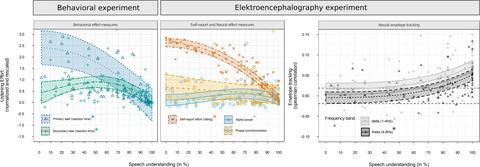当前位置:
X-MOL 学术
›
Eur. J. Nerosci.
›
论文详情
Our official English website, www.x-mol.net, welcomes your feedback! (Note: you will need to create a separate account there.)
Top-down modulation of neural envelope tracking: The interplay with behavioral, self-report and neural measures of listening effort.
European Journal of Neroscience ( IF 3.4 ) Pub Date : 2020-04-19 , DOI: 10.1111/ejn.14753 Lien Decruy 1 , Damien Lesenfants 1 , Jonas Vanthornhout 1 , Tom Francart 1
European Journal of Neroscience ( IF 3.4 ) Pub Date : 2020-04-19 , DOI: 10.1111/ejn.14753 Lien Decruy 1 , Damien Lesenfants 1 , Jonas Vanthornhout 1 , Tom Francart 1
Affiliation

|
When listening to natural speech, our brain activity tracks the slow amplitude modulations of speech, also called the speech envelope. Moreover, recent research has demonstrated that this neural envelope tracking can be affected by top-down processes. The present study was designed to examine if neural envelope tracking is modulated by the effort that a person expends during listening. Five measures were included to quantify listening effort: two behavioral measures based on a novel dual-task paradigm, a self-report effort measure and two neural measures related to phase synchronization and alpha power. Electroencephalography responses to sentences, presented at a wide range of subject-specific signal-to-noise ratios, were recorded in thirteen young, normal-hearing adults. A comparison of the five measures revealed different effects of listening effort as a function of speech understanding. Reaction times on the primary task and self-reported effort decreased with increasing speech understanding. In contrast, reaction times on the secondary task and alpha power showed a peak-shaped behavior with highest effort at intermediate speech understanding levels. With regard to neural envelope tracking, we found that the reaction times on the secondary task and self-reported effort explained a small part of the variability in theta-band envelope tracking. Speech understanding was found to strongly modulate neural envelope tracking. More specifically, our results demonstrated a robust increase in envelope tracking with increasing speech understanding. The present study provides new insights in the relations among different effort measures and highlights the potential of neural envelope tracking to objectively measure speech understanding in young, normal-hearing adults.
中文翻译:

自上而下的神经包络跟踪调制:与听觉行为的行为,自我报告和神经测量之间的相互作用。
聆听自然语音时,我们的大脑活动会跟踪语音的慢幅度调制,也称为语音包络。此外,最近的研究表明,这种神经包络跟踪可能会受到自顶向下过程的影响。本研究旨在检查神经包络跟踪是否受人在聆听过程中花费的精力所调节。包括五种量度量化听觉努力的措施:基于一种新颖的双任务范式的两种行为措施,一项自我报告的努力措施以及与相位同步和α功率相关的两种神经措施。在十三名正常听觉的年轻成年人中记录了脑电图对句子的反应,呈现出各种特定于受试者的信噪比。对这五个量度的比较显示,听觉努力作为语音理解的函数会产生不同的影响。随着语音理解的增加,对主要任务和自我报告的努力的反应时间减少。相反,在中级语音理解水平上,对次要任务的反应时间和alpha功率表现出最大努力的峰形行为。关于神经包络跟踪,我们发现对次要任务的反应时间和自我报告的工作量解释了θ带包络跟踪的一小部分可变性。语音理解被发现强烈调节神经包络跟踪。更具体地说,我们的结果表明,随着语音理解的增强,包络跟踪也有了强劲的增长。
更新日期:2020-05-13
中文翻译:

自上而下的神经包络跟踪调制:与听觉行为的行为,自我报告和神经测量之间的相互作用。
聆听自然语音时,我们的大脑活动会跟踪语音的慢幅度调制,也称为语音包络。此外,最近的研究表明,这种神经包络跟踪可能会受到自顶向下过程的影响。本研究旨在检查神经包络跟踪是否受人在聆听过程中花费的精力所调节。包括五种量度量化听觉努力的措施:基于一种新颖的双任务范式的两种行为措施,一项自我报告的努力措施以及与相位同步和α功率相关的两种神经措施。在十三名正常听觉的年轻成年人中记录了脑电图对句子的反应,呈现出各种特定于受试者的信噪比。对这五个量度的比较显示,听觉努力作为语音理解的函数会产生不同的影响。随着语音理解的增加,对主要任务和自我报告的努力的反应时间减少。相反,在中级语音理解水平上,对次要任务的反应时间和alpha功率表现出最大努力的峰形行为。关于神经包络跟踪,我们发现对次要任务的反应时间和自我报告的工作量解释了θ带包络跟踪的一小部分可变性。语音理解被发现强烈调节神经包络跟踪。更具体地说,我们的结果表明,随着语音理解的增强,包络跟踪也有了强劲的增长。


























 京公网安备 11010802027423号
京公网安备 11010802027423号